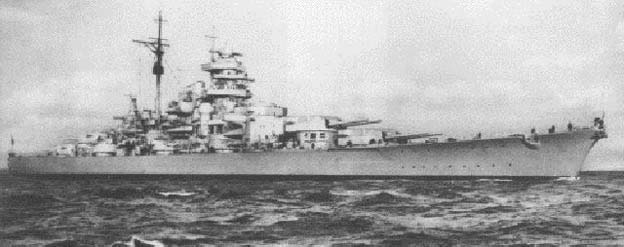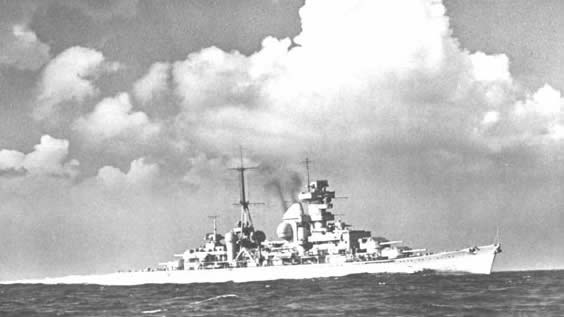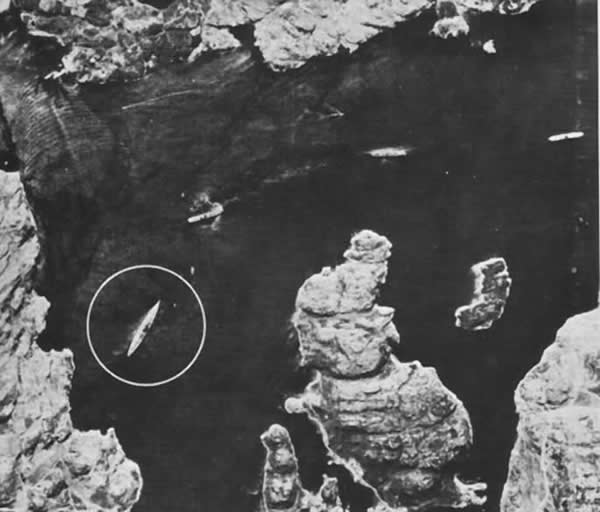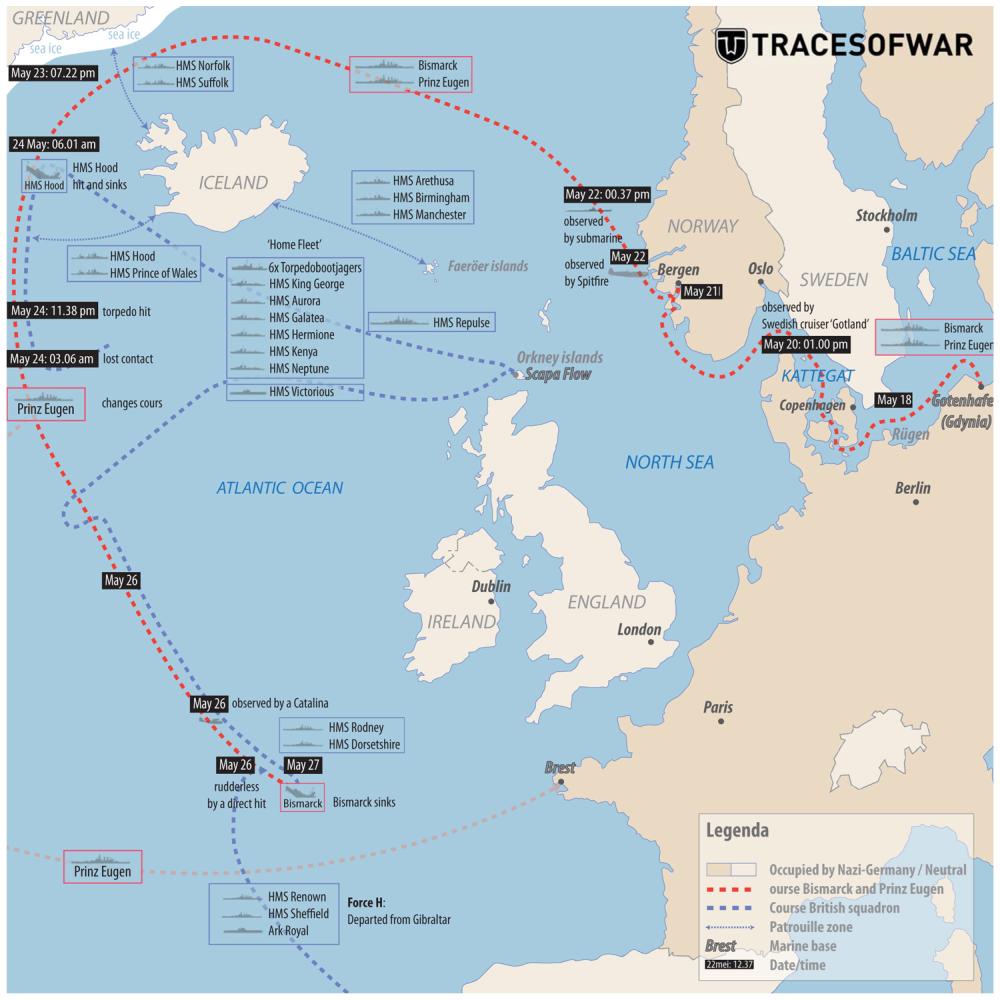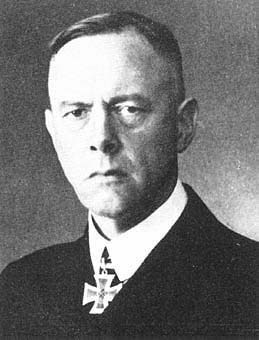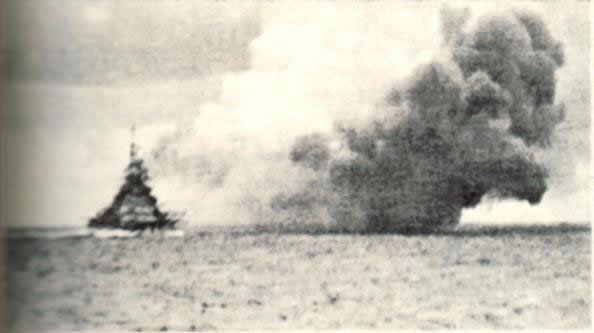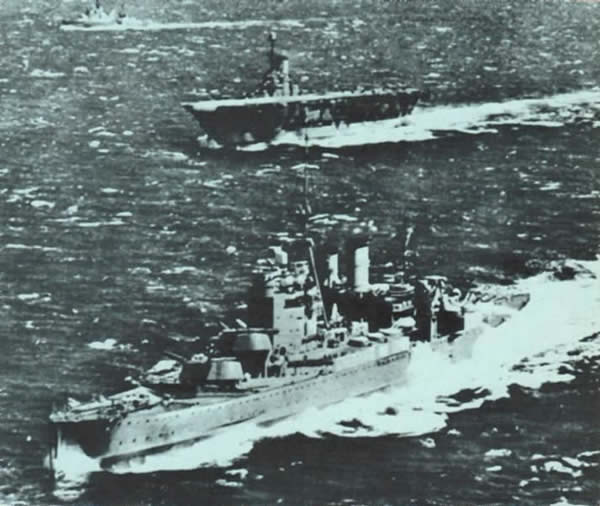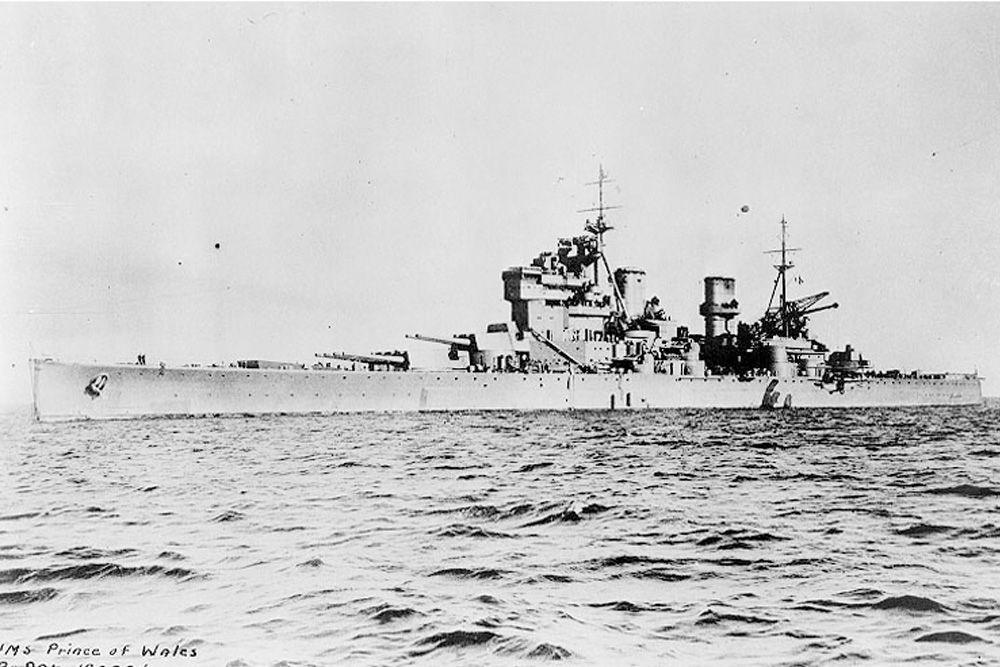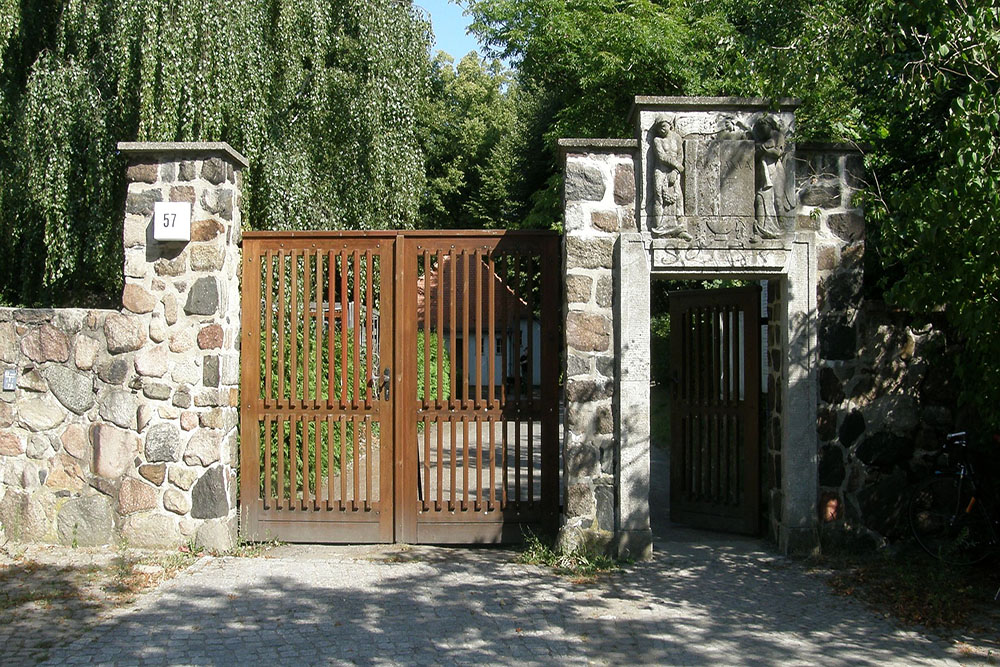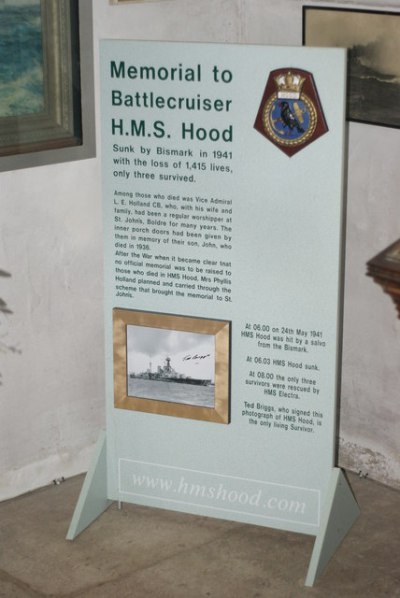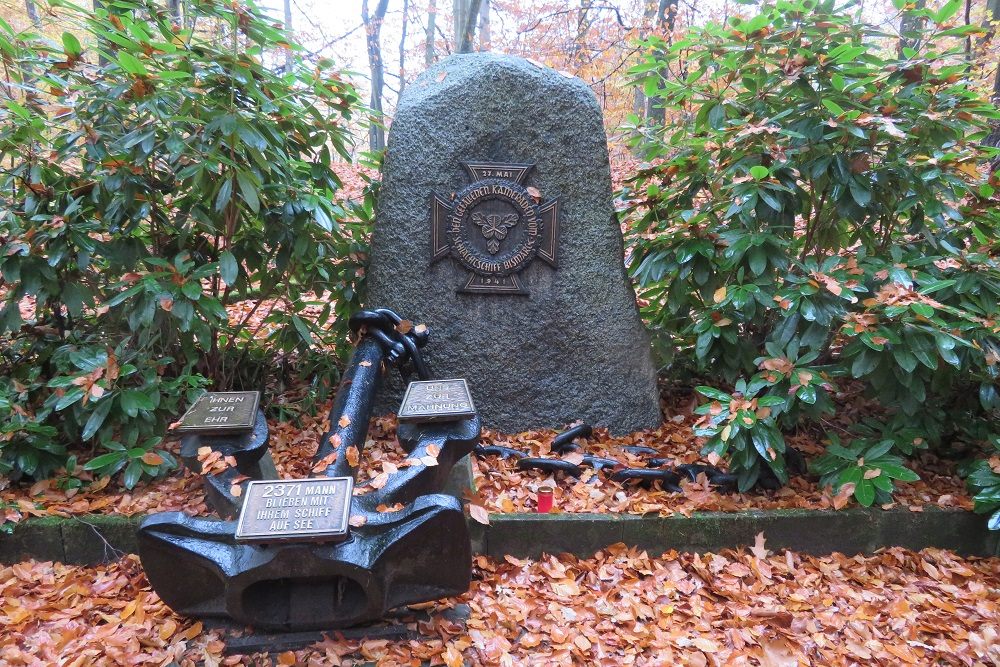Introduction
Up until 1938, Germany had never reckoned with the possibility of entering into a conflict with Great Britain in which the Kriegsmarine would play a major part. In the fall of 1938, Plan Z was launched, entailing the construction of 10 battleships, 12 large armored vessels, 4 aircraft carriers, 5 heavy cruisers, 16 light cruisers and numerous other smaller vessels.
The fleet, in the strength of Plan Z, would be operational in 1948. Hitler also promised he would not use this fleet for political purposes before 1946 as a powerful battle fleet represented a strong political pressure. When the Second World War broke out in 1939, not yet 15 % of this ambitious plan had been achieved.
The Kriegsmarine did however possess the following elements of Plan Z:
- 2 battleships and 2 under construction, Bismarck and Tirpitz
- 3 armored vessels
- 2 heavy cruisers and 3 under construction
- 2 aircraft carriers under construction, Seydlitz and Graf Zeppelin
In addition, the Kriegsmarine possessed a fair number of smaller vessels with quite a few still under construction. This fleet paled however in comparison to the Royal Navy which possessed 12 battleships, 3 battlecruisers and 7 aircraft carriers with many others under construction.
Bismarck, the first of two heavy battleships, (over 40,000 BRT) was launched by the Kriegsmarine on February 14, 1939 with the usual ceremonies. Final construction was completed on August 24, 1940. From that moment on, she began her sea trials until she was commissioned.
Bismarck was to lead a short but very powerful life. Her sea voyage was very remarkable and audacious and this had severe consequences for the remainder of the war on British as well as on German side.
Definitielijst
- Kriegsmarine
- Germa navy. Part of the Wehrmacht next to Heer and Luftwaffe.
Planning
As the Kriegsmarine was not strong enough to engage the Royal Navy directly, the German military leadership decided to cut off the transport of goods by sea to Great Britain. Relatively fewer vessels were needed for this and it could result in severe problems for the British, dependent as they were on this life line across the ocean.
For this tactic the Kriegsmarine made extensive use of U-boats (submarines) and various surface vessels as well, called raiders — converted freighters, sailing under neutral flag — and warships of various sizes.
An operation was drafted in which a powerful German flotilla would break out into the Atlantic to hunt down and attack convoys. This flotilla would deliver so much firepower that almost any convoy could be all but destroyed, provided the Royal Navy would not send powerful escorts with each convoy. Unfortunately, however, the British had too few ships at their disposal for this. This action was baptized Operation Rheinübung (Rhine exercise).
Initially, this powerful German fleet would consist of the battleship Bismarck — at the time the most powerful battleship in the world — and the battleships Scharnhorst and Gneisenau. This would become an extremely powerful German flotilla and the Royal Navy would encounter serious difficulties in assembling a force of comparable strength to counter this threat.
Between January 22 and March 22, 1941 Scharnhorst and Gneisenau had undertaken a similar action and managed to sink 22 Allied vessels, totaling over 110,000 BRT between them. Admiral Günther Lütjens had been in command of this operation and would also be in charge of Operation Rheinübung.
Following air raids on Brest in France, Scharnhorst and Gneisenau were damaged to such an extent they could not participate in Operation Rheinübung. It was therefore decided to send the new heavy cruiser Prinz Eugen along with Bismarck.
Definitielijst
- battleship
- Heavily armoured warship with very heavy artillery.
- cruiser
- A fast warship with 8,000 – 15,000 ton displacement, capable to perform multiple tasks such as reconnaissance, anti-aircraft defence and convoy protection.
- Kriegsmarine
- Germa navy. Part of the Wehrmacht next to Heer and Luftwaffe.
The operation begins
On Thursday, May 8, the officers of Bismarck and Prinz Eugen were briefed about Operation Rheinübung by Admiral Lütjens and received orders to sail for the island of Rügen independently where both vessels would rendezvous.
After both vessels had met, the order to sail was received. In the afternoon of Sunday, May 18, 1941 both vessels weighed anchor and left the port of Gotenhafen in Poland on their way to Norway, escorted by a minesweeper and the destroyers Z-16 and Z-23. Around 22:30 hours, Z-10 joined them.
The Kattegat (the strait between Denmark and Sweden) was reached on May 20, around 13:00 hours and the flotilla was spotted by the Swedish warship Gotland which immediately sent a report to the Swedish navy which in turn forwarded the information to the Royal Navy (Sweden was officially neutral). The British already knew about this action but were in the dark about when and where it would take place or what was the composition of this flotilla. Photographic reconnaissance from the air revealed a flotilla consisting of 3 Leberecht-Mass class destroyers, a cruiser and a very large warship, sailing between Denmark and Sweden on a northeasterly course.
Admiral Lütjens found visibility during the day far too good and decided to lay low in Norway (the German vessels wanted to remain hidden at all costs) and resume the action a few days later in darkness. On Wednesday, May 21, the vessels anchored in a fjord near the Norwegian city of Bergen. Both vessels were repainted, supplies were delivered and Prinz Eugen was refueled.
The German intelligence service informed Lütjens that all heavy British warships were still berthed at their home base Scapa Flow in northern Scotland and there were no signs of imminent departure.
As the British were eager to know where these vessels were and what they were up to, photo reconnaissance flights were made over the Norwegian fjords. In the afternoon of May 21, pictures of the vessels were taken by a Supermarine Spitfire. Now the British knew their location and orders were issued to bomb them with aircraft.
For his breakout into the Atlantic from Norway, Admiral Lütjens could choose between two routes which offered good possibilities. The first was from Norway between the Faröer Islands and Iceland, the second was between Iceland and Greenland. The choice was a difficult one and would be postponed until the vessels had departed.
The break out
On May 21, around 23:00 hours, the flotilla left the Norwegian coast behind and headed for the Atlantic. Meanwhile the weather had deteriorated, it was heavily overcast and visibility was almost zero. That night, the British launched a heavy attack in extremely poor visibility on the location where Bismarck had been spotted last. Obviously, no hits were scored as she had already left.
The next morning, at 05:00 hours, the three destroyers left the flotilla and returned to Norway as planned. They had completed their mission, protecting the vessels against possible enemy submarines. The decision to break out either north or south from Iceland had not yet been taken.
On May 22, at 12:37, the flotilla was spotted by a British submarine and the entire Royal Navy swung into high gear. The following actions were undertaken:
- H.M.S. Norfolk and H.M.S. Suffolk (heavy cruisers) started patrolling in the Denmark Strait between Iceland and Greenland
- H.M.S. Hood (a battlecruiser) and H.M.S. Prince of Wales (a new battleship) set off to patrol to the southwest of Iceland.
- H.M.S. Arethusa, H.M.S. Birmingham and H.M.S. Manchester (light cruisers) started patrolling between the Faröer Islands and Iceland.
- H.M.S. King George V, H.M.S. Victorious, the light cruisers H.M.S. Aurora, H.M.S. Galatea, H.M.S. Hermione, H.M.S. Kenya and H.M.S. Neptune along with six destroyers left Scapa Flow in the direction of Iceland. H.M.S. Repulse was to join them later.
At 23:20 hours the order was finally given as to which route the German flotilla was to take. It was opted to sail between Iceland and Greenland, a stretch of water 24 to 32 nautical miles wide — very narrow in a maritime sense — with ice on one side and Iceland on the other.
In the early evening of May 22, the inevitable happened: Bismarck picked up a contact on her radar and hydrophones. Prinz Eugen was alerted and the alarm sounded. The vessel was only visible for a short time at a distance of about 6 nautical miles and it swiftly disappeared into the fog. The unfamiliar vessel was identified as a cruiser — later on it turned out to be H.M.S. Suffolk — and since it was visible for such a short time, aiming the German guns proved impossible. The Royal Navy now knew the location of Bismarck and Prinz Eugen so everything possible was done to prevent the German vessels from breaking out into the Atlantic. The ocean being so vast, there was hardly any chance of finding the vessels again and therefore, convoys were in danger.
About an hour after the alarm sounded aboard Bismarck, fate struck again. Radar picked up a ship in another position and the turrets were turned in the correct direction. Visibility was fine and fire was opened on the British cruiser. It turned out to be H.M.S. Norfolk. Five rounds were fired without success before the cruiser disappeared behind a fog bank. This gunfire rendered Bismarck`s forward radar inoperable because of the severe vibration. From then on H.M.S. Norfolk and H.M.S. Suffolk continued to shadow the German flotilla.
Owing to Bismarck`s unserviceable radar, Prinz Eugen steamed in front of her. The British cruisers continued shadowing the German vessels, although the Germans attempted to shake them off and even turned to try and catch them by surprise but to no avail.
Interception
In the early hours of the morning of May 24, at 05:15 hours, the hydrophones of Prinz Eugen picked up a contact at a distance of 17.2 nautical miles. Additional lookouts were posted immediately and the alarm was sounded. At 05:37, smoke could finally be seen on the horizon at a distance of 16.7 nautical miles and at 05:43, another vessel was spotted. It was assumed there were two additional cruisers shadowing the German flotilla. According to the German intelligence service, nothing was known about capital warships being in the vicinity.
The German flotilla had been ordered to avoid any engagement unless when necessary to attack an Allied convoy. As the two British vessels were on interception course it was decided to turn slightly away from them. This could offer the German flotilla a chance to outrun the British vessels, certainly when they turned out to be older — those were not so fast. It would also give them time to take decisions. The two flotillas steamed almost on parallel courses and approached each other slowly. On the present heading, it would take them about 15 minutes to come within range.
The British vessels had been dispatched to intercept the German flotilla and therefore they turned a little more towards the German ships. As a result of this course alteration, it would take five minutes to get within firing range. In response, the German vessels altered course again to avoid a possible engagement. At 05:49, 12 minutes after the British ships had been spotted by the Germans, the distance between them had decreased to 12.4 nautical miles and orders to fire could be issued any minute.
Admiral Holland, commander of the two British ships, H.M.S. Prince of Wales and H.M.S. Hood, once more ordered to turn towards the German flotilla. The British vessels were more powerful at shorter range, hence they intended to decrease the distance between them and the German ships as quickly as possible.
H.M.S. Hood was a battlecruiser, meaning it was equipped with the armament of a battleship but with the armor of a cruiser; in particular its horizontal armor — the decks for instance — was lighter than that of a battleship. Shells fired over long distances usually strike from above, hitting the horizontal decks. As vessels approach each other, shells do not penetrate from above but sideways in a shallower angle. H.M.S. Prince of Wales was a brand new battleship with sufficient horizontal and belt armor.
The German flotilla was still unable to properly identify both British warships as it was still assumed, they were British cruisers shadowing them. There also was confusion among the British as the silhouettes of Bismarck and Prinz Eugen were almost identical so one was mistaken for the other. As the vessels closed in, this view changed. Usually, the leading vessel in such a formation would be the most important but because of Bismarck`s unserviceable radar, they had switched positions.
Admiral Holland ordered both vessels to "Standby to fire. The target is the port (the first) ship." Aboard H.M.S. Prince of Wales the vessel in the rear had just been identified as the Bismarck so the order was ignored and they were ready to fire on the last ship. It was hoped those aboard H.M.S. Hood would recognize this as well so they could switch targets.
Definitielijst
- battleship
- Heavily armoured warship with very heavy artillery.
- cruiser
- A fast warship with 8,000 – 15,000 ton displacement, capable to perform multiple tasks such as reconnaissance, anti-aircraft defence and convoy protection.
- radar
- English abbreviation meaning: Radio Detection And Ranging. System to detect the presence, distance, speed and direction of an object, such as ships and airplanes, using electromagnetic waves.
Confrontation
At 05:52, Admiral Holland ordered to open fire and both vessels fired the first round over a distance of 12.4 nautical miles. The necessary corrections were applied and a second round was fired. Gunners aboard H.M.S. Hood were still unaware they were firing at Prinz Eugen. After their second round, they were ordered to redirect their fire onto the last ship and so they had wasted two rounds. H.M.S. Hood had just entered service in the Royal Navy and was still suffered from teething troubles. After the first round, one of the guns in the forward turret jammed.
Meanwhile the vessels had come within 11.8 nautical miles of each other and Admiral Lütjens realized this would become the real battle. He ordered to turn towards the British so all turrets could be brought to bear instead of only the forward turrets and he also ordered to open fire on the forward vessel — H.M.S. Hood — once the turn was completed.
As Prinz Eugen was the leading vessel, at 05:53 she fired first with all 8 203 mm guns over a distance of 11.3 nautical miles. The caliber was a lot smaller than that of the other vessels but her rate of fire of 4 rounds per minute was much higher. Her muzzle velocity was far higher than the larger calibers, causing the shells to strike faster and corrections could be easily applied. Such a caliber however could not inflict severe damage to the heavily armored guns of a battleship. After a few rounds H.M.S. Hood was struck by a shell which hit the door of a magazine for the 102 mm anti-aircraft guns, causing a raging fire and exploding ammunition. Damage was not critical but severe enough to disrupt operation of the vessel.
Now, at 05:55 hours it was Bismarck`s turn to fire with her 8 380mm guns over a distance of 10.7 nautical miles. The shells would strike after 34 seconds. High spouts of water shot into the air and the necessary adjustments were made before firing again. After a few rounds, the Germans finally had a positive identification of the ships and thought they were dealing with H.M.S. Hood and H.M.S. King George V. It was quite understandable they mistook H.M.S. Prince of Wales for H.M.S. King George V as the vessels were almost identical and H.M.S. Prince of Wales was not yet considered ready for operational service. The vessel was so new, personnel of the shipyard was still aboard and her artillery was still untested. During the battle, this would cause turrets to break down frequently. Admiral Lütjens was very startled as these two vessels were considered the most powerful of the British fleet and he realized this encounter was no coincidence. Obviously, the British were well aware of the German operation.
The end of H.M.S. Hood
Bismarck`s third round was so dangerously close to H.M.S. Hood; it was only a matter of time before direct hits would be scored. Therefore, Prinz EugenHood was ordered to redirect her fire to still untouched H.M.S. Prince of Wales and to sail in front of Bismarck instead of behind her. This was also intended to repel a possible attack by the heavy cruisers H.M.S. Suffolk and H.M.S. Norfolk.
The British vessels had fired various rounds from their forward turrets without success. Once again, they turned away from the Germans in order to bring their aft turrets to bear, deploying all possible fire power. They started their turn at 05:59, this was quickly noticed by the Germans who adjusted their guns.
As Bismarck`s third round fell very close to H.M.S. Hood, the Germans switched to rapid firing. To find a target, one shell is fired each time and only when it hits, the guns can be adjusted accordingly and fired again. As soon as the elevation and direction are correct, a shell will be fired before the previous one hits. For this reason, Bismarck fired three fast rounds after the first three over a distance of some 8.6 nautical miles.
The fourth round fell right next to H.M.S. Hood but the fifth round had a devastating effect. Out of eight shells, seven dropped into the sea but the last one struck right in front of the aft turrets. A towering flame shot out of the hind part of the vessel and shortly afterwards, there was a massive explosion that turned out to be fatal. The shell had probably penetrated the deck and exploded in the magazine of C turret. Another explanation is that fires caused by the hits of Prinz Eugen had already inflicted so much damage that the shell could easily have struck a vital part. The explosion of the magazine certainly meant the end of the vessel. The ship broke in two and started sinking fast. After two minutes she went down, taking hundreds of her crew with her. In the end, only a handful of survivors was rescued.
H.M.S. Prince of Wales acted fast, despite the great loss of H.M.S. Hood. She steered clear of the sinking wreck, held her course, firing continuously and eventually steamed parallel to Bismarck.
The crew of Bismarck and Prinz Eugen were awe struck. They had just destroyed the pride of the Royal Navy without even being hit themselves and the amazement soon turned into wild cheering. As high spouts of water, caused by the shells of H.M.S. Prince of Wales rose alongside, a sense of reality soon returned. There was yet another battleship that could inflict serious damage and at 06:03, the guns were soon turned in the direction of the enemy vessel.
Both German vessels started firing rapidly at the British cruiser over a distance of meanwhile 7.5 nautical miles; the shells took 20 seconds to hit. At this distance it was certainly possible a direct hit would be scored, causing death and destruction all over the ship. Soon, a shell from Bismarck slammed straight through the bridge structure of the enemy ship without exploding. A sizable number of officers was killed but the captain miraculously escaped unharmed. Command of the ship was swiftly relocated to the hind part of the ship. Prinz Eugen scored a few hits herself as well but without serious damage. Soon after, Bismarck herself scored two hits in rapid succession, one against the spotter plane hoist, causing massive damage by shrapnel, the other hit just below the waterline but did not explode, causing only a minor hole in the hull.
Without realizing it, H.M.S. Prince of Wales placed a few hits on Bismarck as well. These did not influence her fighting power but would prove to be of great importance to the further progress of the operation.
The logical decision of H.M.S. Prince of Wales to retreat was taken at 06:05 hours. She withdrew behind a smoke screen, firing continuously. At 06:09, the German flotilla decided not to waste any more munition on an enemy it could not see. This strange engagement was over. The Germans also decided not to pursue the enemy cruiser as they would not take the risk of meeting other large British warships which might be heading for this battle.
The outcome of the battle
In the course of this engagement, Bismarck was hit three times. The first shell had hit amidships, did not explode however but did destroy the captain`s motor launch and the equipment to launch her spotter plane. The second shell hit amidships as well, just below the belt armor. A boiler room and a generator were wrecked and five crew members sustained injuries. The third shell caused the most extensive damage, it struck below the waterline, slammed through two fuel tanks and destroyed a valve, cutting off the fuel supply to the engines and ending in the water on the other side of the ship without exploding. Large amounts of oil flowed into the sea and the fuel in the tanks was contaminated with salt water.
Bismarck had lost a considerable amount of fuel, drew a large oil slick behind her, could reach a maximum speed of just 28 knots and was taking in water. This caused Admiral Lütjens to decide to make for a dry dock for repairs, the only question being, which dry dock. He could return to German via Norway or head for France. If he opted for Germany, he would have to return via almost the same route. If he headed for France, he would have the advantage of protection from U-boats and the Luftwaffe, so France was chosen and Bismarck headed for the dry dock at St. Nazaire.
At 08:01 he informed the German high command about the damage sustained, his intention to head for St. Nazaire and to leave Prinz Eugen enabling her to continue her actions in the Atlantic while Bismarck set course for the dry dock.
After he battle, H.M.S. Prince of Wales joined H.M.S. Norfolk and H.M.S. Suffolk still shadowing the two German battleships. The first ship had sustained various hits but was still able to join in battle and could still be helpful later on in the campaign. These three vessels, commanded by Admiral Wake-Walker, continued shadowing their prey.
Definitielijst
- battleship
- Heavily armoured warship with very heavy artillery.
- caliber
- The inner diameter of the barrel of a gun, measured at the muzzle. The length of the barrel is often indicated by the number of calibers. This means the barrel of the 15/24 cannon is 24 by 15 cm long.
- cruiser
- A fast warship with 8,000 – 15,000 ton displacement, capable to perform multiple tasks such as reconnaissance, anti-aircraft defence and convoy protection.
- Luftwaffe
- German air force.
To France
From 12:40 onwards, the two German battleships headed south and made a few attempts to shake off their pursuers by reducing speed, then accelerate and change course drastically. All to no avail however as radar made the pursuit by the British very easy.
Meanwhile, in addition to the three pursuing vessels, two other flotillas were heading for the German ships. The first was Force H from Gibraltar, commanded by vice-Admiral Sir James Somerville and consisting of the battlecruiser H.M.S. Renown, the aircraft carrier H.M.S. Ark Royal and the light cruiser H.M.S. Sheffield. The second group, tasked with patrols and convoy duties, consisted of the battleships H.M.S. Rodney, Ramilies, Revenge and the cruisers H.M.S. London and Edinburgh. This was a massive battle group for tracking down and destroying a battleship and a cruiser but the loss of once mighty H.M.S. Hood had hit the British Admiralty hard and it wanted to track down and destroy Bismarck at any cost, also because of the propaganda involved.
The German high command and Lütjens decided that Bismarck would set course for St. Nazaire and Prinz Eugen would leave Bismarck to hunt for convoys in the Atlantic on her own. In order to enable Prinz Eugen to shake of her pursuers, Bismarck would execute an evasive maneuver. The weather was ideal for such an action: visibility had decreased slightly and fog was coming in.
On May 24, at 18:14 hours, while the German ships were hidden in a fog bank, Bismarck turned 180 degrees, accelerated to 27 knots and opened fire on her pursuers. Prinz Eugen continued at full speed and was soon out of radar range of the British ships.
At 18:30, Bismarck opened fire on H.M.S. Suffolk over a distance of 9.7 nautical miles, causing the cruiser to turn away immediately and disappear behind a smoke screen. Between 18:40 and 18:56 the two vessels fired at each other but at a distance of 14.5 to 16 nautical miles, a hit would be highly unlikely. Subsequently, Bismarck continued on course for France. Prinz Eugen had escaped successfully.
Definitielijst
- battleship
- Heavily armoured warship with very heavy artillery.
- cruiser
- A fast warship with 8,000 – 15,000 ton displacement, capable to perform multiple tasks such as reconnaissance, anti-aircraft defence and convoy protection.
- propaganda
- Often misleading information used to gain support among supporters or to gain support. Often used to accomplish ideas and political goals.
- radar
- English abbreviation meaning: Radio Detection And Ranging. System to detect the presence, distance, speed and direction of an object, such as ships and airplanes, using electromagnetic waves.
Bismarck is caught
Late at night, Force H came within flying range of Bismarck and H.M.S. Victorious immediately launched an air attack, consisting of nine Swordfish biplanes which took off at 22:10 followed by three Fulmars at 23:00 and another two at 01:00.
At 23:30, the Swordfishes sighted Bismarck and went into the attack. She was struck by one torpedo amidships which hit her belt armor causing insignificant damage only. However, one crew member was killed by the explosion and six injured. Despite the anti-aircraft fire, all Swordfishes and Fulmars safely returned to the carrier, except two Fulmars which ran out of fuel.
As Prinz Eugen had shaken off her pursuers, Bismarck attempted the same. She had noticed the vessels were always sailing on the same side and had started to zig zag to evade possible U-boats. Bismarck turned through 300 degrees, steaming almost in a circle. The British vessels lost radar contact and started independent searches. Bismarck however was no longer in front of her pursuers but due to her 300 degree turn, was now alongside and even behind them. She had shaken off her pursuers and set course for St. Nazaire.
Search by the British
The British Admiralty tried to guess where Bismarck was going but whether she headed out into the Atlantic, towards France, towards Germany or to a rendezvous with a supply vessel was completely unknown. British carrier H.M.S. Victorious launched a search with her spotter planes but in the wrong direction.
Admiral Lütjens, still thinking he was being pursued by British vessels, transmitted a long message to the German high command, informing them about the battle against H.M.S. Hood, the damage he had sustained, the escape of Prinz Eugen and his plans for Bismarck. The transmission of this message was picked up by British vessels. They could neither decipher the message nor pinpoint her exact location but they did get an idea where to look for her, namely in the direction of the French coast. Halfway through the afternoon, Bismarck slowed down to a more economical speed of 20 knots to prevent her from running out of fuel before reaching St. Nazaire. The damage sustained was the result of her engagement with H.M.S. Hood and H.M.S. Prince of Wales.
On May 26, at 03:00 hours, two Consolidated PBY-5 Catalina sea planes took off from a base in Northern Ireland to carry out a long-distance search for Bismarck. They were ordered to search the route between France and the last known location of the ship. At 10:30, one of the Catalina`s sighted a large battleship and half an hour later, a Fairey Swordfish from H.M.S. Ark Royal, which had just arrived in the area, joined in to take a look at the large war ship which turned out to be Bismarck. A few minutes later, the light cruiser H.M.S. Sheffield also made contact. After a search of 31 hours, Bismarck had been located.
The end of Bismarck
The only way to destroy Bismarck was to slow her down so the war ships could catch up with her. This action could only be undertaken by the carrier H.M.S. Ark Royal which had airplanes with a sufficient range and were armed with torpedo`s. At 14:50, 15 Fairey Swordfish biplanes took off to launch an attack on Bismarck. The pilots made visual contact at 15:40 and launched their attack on what they thought to be Bismarck but scored no hits. They had however mistaken the light cruiser H.M.S. Sheffield for Bismarck.
At 19:15, H.M.S. Ark Royal launched another attack with 15 Swordfishes, knowing it would be the last opportunity as the next day she would come within range of the Luftwaffe for protection. The attack began at 20:47 hours. The first torpedo struck amidships, causing no damage. The second torpedo however struck the rudder, jamming it at an angle of 12 to 15 degrees, causing the vessel to steam in a large circle.
As Bismarck was now disabled, the British war ships closed in for the kill but the real fight began the next morning in daylight.
Bismarck`s superstructure had been utterly destroyed but she was still afloat. Ernst Lindemann — her captain — therefore decided to lay explosive charges in order to scuttle her so she would not fall into enemy hands. At the same time when H.M.S. Dorsetshire, fired three torpedoes, the charges went off and Bismarck went down on May 27 at 10:39. Whoever was responsible for the final blow to Bismarck only became clear long after the war.
The end
A total of 116 survivors out of the more than a thousand sailors were rescued of which one died en route to Great Britain. This was due to the sudden departure of H.M.S. Dorsetshire and H.M.S. Maori because of possible threats by U-boats. The other vessels had already left because of a fuel shortage.
Bismarck`s career was short-lived but violent and she caused great unrest among the British after the sinking of H.M.S. Hood, the darling of the Royal Navy. This event was of profound influence however on the decision by the Germans to consider their U-boat fleet more important than their surface fleet.
In 1989, the wreck of the Bismarck was located at a depth of 15,400 feet in the Atlantic Ocean by Dr. Robert Bruce Ballard. In 2001, an expedition to the wreck of Bismarck was undertaken by James Cameron. By using robots, it finally became clear that she went down as a result of the charges the crew had laid themselves. It turned out; the torpedoes launched by H.M.S. Dorsetshire had not penetrated the belt armor after all.
Definitielijst
- battleship
- Heavily armoured warship with very heavy artillery.
- cruiser
- A fast warship with 8,000 – 15,000 ton displacement, capable to perform multiple tasks such as reconnaissance, anti-aircraft defence and convoy protection.
- Führer
- German word for leader. During his reign of power Adolf Hitler was Führer of Nazi Germany.
- Luftwaffe
- German air force.
- radar
- English abbreviation meaning: Radio Detection And Ranging. System to detect the presence, distance, speed and direction of an object, such as ships and airplanes, using electromagnetic waves.
- torpedo
- A weapon of war. A cigar shaped body fitted with explosives and a propulsion and control mechanism. Intended to target after launch a nearby enemy ship and disable it by underwater explosion.
- U-boat
- The German name for a submarine. German U-Boats (Submarines) played a very important role during the course of warfare until May 1943. Many cargo and passenger ships were torpedoed and sunk by these assassins of the sea.
Information
- Article by:
- Frank van der Drift
- Translated by:
- Arnold Palthe
- Published on:
- 13-09-2020
- Last edit on:
- 30-09-2024
- Feedback?
- Send it!
- 06-'41: For 1750 Miles They Chased the Bismarck
- 06-'41: How the Royal Navy Avenged the Hood
- 06-'41: I Was There! - How Our Catalina Shadowed the Bismarck
- 06-'41: I Was There! - I Saw One Vast Explosion - The Hood Had Gone
- 06-'41: 'Closer, Get Closer Yet to the Bismarck!'
- 06-'41: I Was There! - We Helped in the Sinking of the Bismarck
- 06-'41: I Was There! - We Fired the Torpedoes that Finished Her
- 06-'44: The War at Sea
- 11-'44: The War at Sea
- 06-'46: Why 'Scharnhorst' and 'Gneisenau' Escaped
- 10-'46: His Majesty's Ships - H.M.S. King George V
- 11-'46: His Majesty's Ships - H.M.S. Aurora
The War Illustrated
Related sights
Sources
- Cartier Raymond - De tweede wereldoorlog (deel 1), Van Holkema & Warendorf Bussum
- Battleship Bismarck
- KBismarck.com
- Schlachtschiff Bismarck
